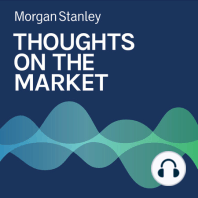3 min listen

Mike Wilson: Inflation Causes Mixed Signals
Mike Wilson: Inflation Causes Mixed Signals
ratings:
Length:
4 minutes
Released:
Nov 8, 2021
Format:
Podcast episode
Description
As we head towards year end, stock and bond markets appear to be sending mixed signals for the year ahead. For investors, the truth could lie somewhere in the middle.----- Transcript -----Welcome to "Thoughts on the Market." I'm Mike Wilson, Chief Investment Officer and Chief U.S. Equity Strategist for Morgan Stanley. Along with my colleagues, bringing you a variety of perspectives, I'll be talking about the latest trends in the financial marketplace. It’s Monday, November 8th at 2:00PM in New York. So, let's get after it. As we enter the final stretch of the year, various markets appear to be sending very different signals about what to expect over the next year. Let’s start with Bonds where the longer-term yields have fallen sharply over the past few weeks. In fact, the moves have been so dramatic, several leading macro funds had their worst month on record in October. Some of this move is due to the fact that these same investors were all short bonds as central banks were expected to begin the long process of tightening monetary policy, perhaps faster than what was priced a few months ago. The reason for this view was very simple: inflation has proven to be much higher than the central banks expected, and they would be forced to respond to that development by raising rates sooner than what they might prefer to do. Indeed, over the past few months, many central banks around the world have raised rates while others have begun to taper asset purchases and even end them altogether. In other words, these traders were correct in their fundamental assessment of what was about to happen, but long-term rates went down instead of up. While the extreme positioning clearly played a role in the magnitude of the move in longer term rates, the fundamental question is why did they fall at all? One possible reason is the bond market may be discounting what we have been talking about on this podcast for weeks—that the first half of next year is likely to see a material slowing in both economic and earnings growth as fiscal stimulus from this year wears off. Furthermore, with the legislative process breaking down on the Build Back Better program, that risk has only increased. It also means less issuance of Treasury securities which directly helps the supply and demand imbalance many macro and bond traders were expecting as the Fed begins to taper asset purchases this month. On the other side of the spectrum has been stocks. Here, we have seen higher prices for the major indices almost every day for the past 5 weeks, suggesting growth next year is not only going to be fine but may be understated by analysts. Stocks may also be taking the lower interest rates as good news for valuations. After all, much of the correction in September was due to lower valuations as the markets started to worry about central banks tightening and rates moving higher. On that score, price/earnings multiples in the US have risen by 7.5% over the past 5 weeks, one of the largest rises we’ve ever witnessed in such a short period of time. Such a rise in P/Es like this usually happen for one of two reasons: either the market thinks earnings estimates are about to go up a lot or interest rates are going to fall. The conflict here is that better growth is not compatible with lower rates. A valid explanation for the divergence could be that the potential failure of Build Back Better means no new corporate taxes. So, while the economy may be hurt by this legislative delay it could be friendly to earnings. In keeping with our narrative over the past month, we think the main reason for the divergence in messaging between stock and bond markets can be explained by the fact that retail and other passive inflows to equity markets continue at a record pace. It’s also the seasonal time of the year when institutional investors are loathe to leave the party early for fear of missing out and falling behind their benchmarks, something that they have had a harder time keeping up with t
Released:
Nov 8, 2021
Format:
Podcast episode
Titles in the series (100)
Mike Wilson: How Confident Are U.S. Businesses in the Economy? by Thoughts on the Market